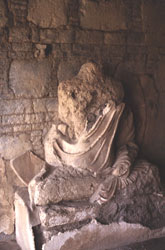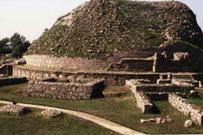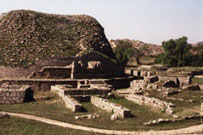The stupa of Dharmarajika was started by Asoka. It is about 3 kilometers from the Taxila museum on a metalled road ; a new road is being built towards it .Its importance lies in the fact that one of Buddha’s body-relics was buried there . The name Dharmarajika comes from Dharmaraja, a name given to Buddha who was the true Dharma Raja [ i.e. Law Lord ] according to Marshall.

The pictures given here show the main stupa mound, the chapels surrounding it are mostly gone except for the foundations and a few stucco figures. The pictures are given here of these stucco. Also one can see the great tank on one side of the stupa at Dharmarajika . The place is very serene and is ideally located at the foot of the Hathial Spur and the Tamra nallah (stream)
According to Marshall " In the chapel G5 was found some of the most interesting relics yet discovered in this part of India. The find was made near the back wall of the chapel opposite the Great Stupa and about a foot below the original floor. It consisted of a vase-like casket of gray micaceous schist with a silver vase inside, and in the latter an inscribed scroll of silver and a small gold casket containing some minute bone relics. A heavy stone placed over the deposit had been crushed by the fall of the roof and had broken both the casket and the silver vase but had left the gold reliquary uninjured and chipped only a few fragments from the edge of the scroll, nearly all of which was recovered .The record, which is in the Kharoshti character and dated in the year 136[ A.D. 78] tells us that the relics were those of the Lord Buddha .
It is not known where this relic has gone; whether it is in the Taxila museum or was taken to be kept at Lahore Museum or was forwarded to the Museum at Delhi. Recently in August a Japanese tourist delegation had come to lead a peace march on the occasion of the anniversary of the Atomic Bombings of Hiroshima and Nagasaki.





